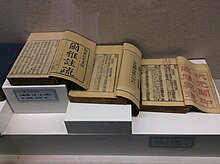Erya
| Erya | |||||||||||||||||||||||||||||||

Erya exhibit at Chinese Dictionary Museum (Jincheng, Shanxi Province)
|
|||||||||||||||||||||||||||||||
| Traditional Chinese | 爾雅 | ||||||||||||||||||||||||||||||
|---|---|---|---|---|---|---|---|---|---|---|---|---|---|---|---|---|---|---|---|---|---|---|---|---|---|---|---|---|---|---|---|
| Simplified Chinese | 尔雅 | ||||||||||||||||||||||||||||||
|
|||||||||||||||||||||||||||||||
| Transcriptions | |
|---|---|
| Standard Mandarin | |
| Hanyu Pinyin | Ěryǎ |
| Gwoyeu Romatzyh | Eelyea |
| Wade–Giles | Erh3-ya3 |
| IPA | [àɚ jà] |
| Yue: Cantonese | |
| Yale Romanization | Yíh-ngáah |
| Jyutping | Ji5-ngaa5 |
| Southern Min | |
| Hokkien POJ | Ní-ngá |
| Middle Chinese | |
| Middle Chinese | nyé ngǽ |
| Old Chinese | |
| Baxter-Sagart | *n[e][r]ʔ N-ɢˤraʔ |
The Erya or Erh-ya is the oldest surviving Chinese dictionary or Chinese encyclopedia known. Bernhard Karlgren (1931: 49) concluded that "the major part of its glosses must reasonably date from" the 3rd century BC.
Chinese scholars interpret the first title character ěr (; "you, your; adverbial suffix") as a phonetic loan character for the homophonous ěr (; "near; close; approach"), and believe the second yǎ (; "proper; correct; refined; elegant") refers to words or language. According to W. South Coblin: "The interpretation of the title as something like 'approaching what is correct, proper, refined' is now widely accepted" (1993:94). It has been translated as "The Literary Expositor" or "The Ready Rectifier" (both by James Legge), "Progress Towards Correctness" (A. von Rosthorn), and "The Semantic Approximator" (Needham et al.).
The book's author is unknown. Although it is traditionally attributed to the Duke of Zhou, Confucius, or his disciples, scholarship suggests that someone compiled and edited diverse glosses from commentaries to pre-Qin texts, especially the Shijing. Joseph Needham et al. (1986: 191) place the Erya's compilation between the late 4th and early 2nd centuries BCE, with the possible existence of some core text material dating back to the 6th century BCE, and the continued additions to the text as late as the 1st century BCE.
The first attempts to date the different parts of the Erya separately began when the Tang scholar Lu Deming (556-627) suggested that the Duke of Zhou only compiled the Shigu chapter (1), while the rest of the text dated from later (Needham 1986: 190). The Japanese historian and sinologist Naitō Torajirō analyzed the Erya text and concluded it originated in the early Warring States period, with the Jixia Academy having a considerable hand in it from c. 325 BCE onwards, and the text was enlarged and stabilized during the Qin and Western Han dynasty. Naitō connects the Shigu chapter (1) with the first generations of the Confucian School (450-400 BCE), places the family relationships, astronomy, and meteorology chapters (4-8) in the time of Xun Ching 荀卿 (300-230 BCE) with additions as late as 90 BCE, allocates the geographical chapters (9-12) to the late Warring States, Qin, and beginning of Han (300-200 BCE), puts the natural history chapters (13-18) between 300 and 160 BCE, and ascribes the last chapter (19) on domestic animals to the time of Emperor Wen or Emperor Jing of Han (180 to 140 BCE).
...
Wikipedia
